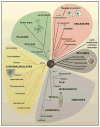Preview. The incredible expanding ancestor of eukaryotes
- PMID: 20211127
- PMCID: PMC3293451
- DOI: 10.1016/j.cell.2010.02.022
Preview. The incredible expanding ancestor of eukaryotes
Abstract
Comparing the genome sequences of free-living organisms in the five eukaryotic supergroups enables predictions to be made about the genome of the last common ancestor of eukaryotes. The genome sequence of the amoeboflagellate Naegleria gruberi reported by Fritz-Laylin et al. (2010) reveals the surprising complexity of this unicellular organism and, by inference, of the last common eukaryotic ancestor.
(c) 2010 Elsevier Inc. All rights reserved.
Figures

Comment on
-
The genome of Naegleria gruberi illuminates early eukaryotic versatility.Cell. 2010 Mar 5;140(5):631-42. doi: 10.1016/j.cell.2010.01.032. Cell. 2010. PMID: 20211133
Similar articles
-
The genome of Naegleria gruberi illuminates early eukaryotic versatility.Cell. 2010 Mar 5;140(5):631-42. doi: 10.1016/j.cell.2010.01.032. Cell. 2010. PMID: 20211133
-
A nonmitochondrial hydrogen production in Naegleria gruberi.Genome Biol Evol. 2014 Apr;6(4):792-9. doi: 10.1093/gbe/evu065. Genome Biol Evol. 2014. PMID: 24682152 Free PMC article.
-
Expression, purification, enzymatic characterization and crystallization of glyceraldehyde-3-phosphate dehydrogenase from Naegleria gruberi, the first one from phylum Percolozoa.Protein Expr Purif. 2016 Nov;127:125-130. doi: 10.1016/j.pep.2016.07.007. Epub 2016 Jul 15. Protein Expr Purif. 2016. PMID: 27426132 Review.
-
A calcineurin-B-encoding gene expressed during differentiation of the amoeboflagellate Naegleria gruberi contains two introns.Gene. 1995 Feb 27;154(1):39-45. doi: 10.1016/0378-1119(94)00860-u. Gene. 1995. PMID: 7867946
-
Whence genes in pieces: reconstruction of the exon-intron gene structures of the last eukaryotic common ancestor and other ancestral eukaryotes.Wiley Interdiscip Rev RNA. 2013 Jan-Feb;4(1):93-105. doi: 10.1002/wrna.1143. Epub 2012 Nov 8. Wiley Interdiscip Rev RNA. 2013. PMID: 23139082 Review.
Cited by
-
Benchmarking orthology methods using phylogenetic patterns defined at the base of Eukaryotes.Brief Bioinform. 2021 May 20;22(3):bbaa206. doi: 10.1093/bib/bbaa206. Brief Bioinform. 2021. PMID: 32935832 Free PMC article.
-
Localization and functional characterization of the alternative oxidase in Naegleria.J Eukaryot Microbiol. 2022 Jul;69(4):e12908. doi: 10.1111/jeu.12908. Epub 2022 May 3. J Eukaryot Microbiol. 2022. PMID: 35322502 Free PMC article.
-
Telomere- and Telomerase-Associated Proteins and Their Functions in the Plant Cell.Front Plant Sci. 2016 Jun 28;7:851. doi: 10.3389/fpls.2016.00851. eCollection 2016. Front Plant Sci. 2016. PMID: 27446102 Free PMC article. Review.
-
Condensins: universal organizers of chromosomes with diverse functions.Genes Dev. 2012 Aug 1;26(15):1659-78. doi: 10.1101/gad.194746.112. Genes Dev. 2012. PMID: 22855829 Free PMC article. Review.
-
An unusual transmembrane helix in the endoplasmic reticulum ubiquitin ligase Doa10 modulates degradation of its cognate E2 enzyme.J Biol Chem. 2011 Jun 10;286(23):20163-74. doi: 10.1074/jbc.M110.196360. Epub 2011 Apr 5. J Biol Chem. 2011. PMID: 21467040 Free PMC article.
References
Publication types
Grants and funding
LinkOut - more resources
Full Text Sources

